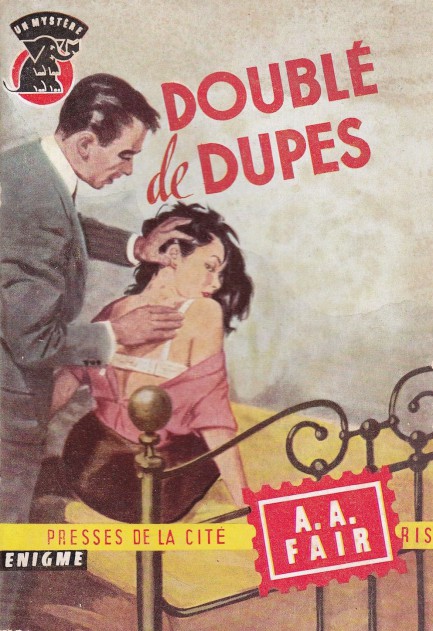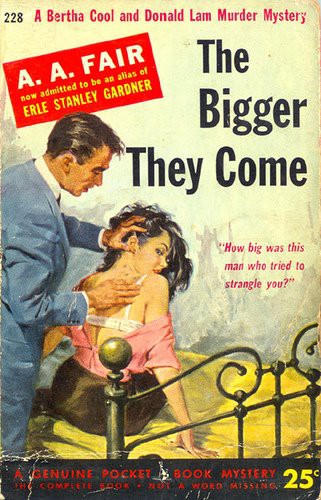| Vintage Pulp | Dec 21 2015 |

Yup, there's something here. Based on your personality I'm inclined to say it's a “666,” but no—they're just bruises.

 A.A. Fair's Doublé de dupes, which is a translation of The Bigger They Come, was first published in hardback in 1939, appeared as a U.S. paperback from Pocket Books in 1952, and above in 1958. It's the first in a series starring sixty-something private investigator Bertha Cool and her pint-sized sidekick Donald Lam. Fair, aka Erle Stanley Gardner, had already made his Perry Mason series a success and the Cool/Lam shift got him out of the courtroom. In this one the protagonists attempt to serve divorce papers, but of course the seemingly simple task falls apart spectacularly, leaving a man dead and Lam under suspicion of having committed a serious crime. The British version's title—Lam to the Slaughter—gives that aspect of the story away immediately. The curious cover art you see here by Maurice Thomas was used on both the U.S. and French versions (a bit of a surprise considering the six year gap) and shows Lam checking out injuries on the femme fatale, who has been attacked by another character. General consensus online is that this series improved greatly after the first couple of entries.
A.A. Fair's Doublé de dupes, which is a translation of The Bigger They Come, was first published in hardback in 1939, appeared as a U.S. paperback from Pocket Books in 1952, and above in 1958. It's the first in a series starring sixty-something private investigator Bertha Cool and her pint-sized sidekick Donald Lam. Fair, aka Erle Stanley Gardner, had already made his Perry Mason series a success and the Cool/Lam shift got him out of the courtroom. In this one the protagonists attempt to serve divorce papers, but of course the seemingly simple task falls apart spectacularly, leaving a man dead and Lam under suspicion of having committed a serious crime. The British version's title—Lam to the Slaughter—gives that aspect of the story away immediately. The curious cover art you see here by Maurice Thomas was used on both the U.S. and French versions (a bit of a surprise considering the six year gap) and shows Lam checking out injuries on the femme fatale, who has been attacked by another character. General consensus online is that this series improved greatly after the first couple of entries.



































































